
Akin to the freedom afforded by the bicycle during this period of quarantine, women in the 1890s discovered a sense of liberation when pedaling on their cycles. No longer did women depend entirely upon men for transportation, and no longer were they encumbered by layers of petticoats. With this newfound autonomy, the bicycle became a symbol of the fight for women’s equality. As noted by the National Women’s History Museum, “Having the ability to be fully self-reliant, often for the first time in their lives, would encourage women to be more courageous in other areas, such as demanding voting rights.”
But while the bicycle led to shifts in gender norms, much to the angst of some, female riders were expected to maintain a sense of grace and femininity atop the apparatus—from the way they outfitted themselves, to the way they dismounted, and even to the method of breathing while pedaling. Essentially, women were expected to adorn the cities and countrysides in which they traversed. Here, we will go over some of the biking decorum suggested by The Indiana Woman, and see how you would fair as a “bicyclienne” in the 1890s. We’re guessing you’ll have a new sense of appreciation for headbands and Fabletics leggings.
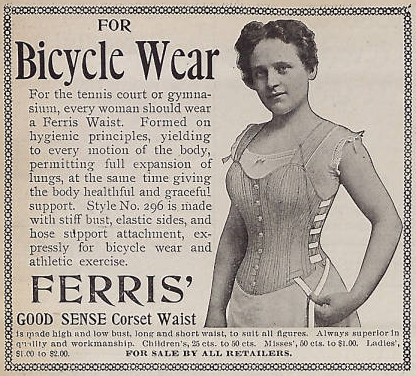
Before you take your bicycle—perhaps the Ben-Hur model—to Cyclorama riding school, it is imperative to assemble an outfit that strikes a winsome yet serious note. The Indiana Woman, in its May 15, 1897 issue, warned riders to avoid sweaters, as the “sight is not pleasing. If you ask your brother about it, his answer will be emphatic almost to the point of rudeness.” Then what should you wear? A “pretty bicycle suit” will do, so long as it is not made of corduroy, unattractive fabric that it is. Brown or gray suits are best, but whatever you do, avoid red, as a “woman awheel attracts enough attention anyway, without even a tiny bit of color in her costume.” The suit’s skirt should almost reach the tops of one’s shoes, and it goes without saying that an underskirt has no place in one’s wardrobe. Bloomers are acceptable undergarments, so long as the waistband has a deep yoke. You do want your waist to remain trim, don’t you?
When it comes to headwear, one writer lamented “Why, O why, will you wear that monstrous hat, tipped with feathers and garlanded with flowers when you are on your wheel?” No! Mademoiselles should “Either buy yourself a bicycle hat, or stay home.” When it comes to footwear, golf stockings paired with “low shoes” are most appropriate (p.9). Whatever you choose, always keep in mind that “There has been such a revulsion of feeling against all things mannish, that ‘advanced’ modes have received their unmistakable death-blow, and cyclists now dress to appear strictly feminine.”
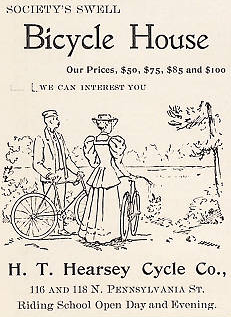
Now that you are sure to please to the eye, it is time to learn to ride, daintily of course. You can head over to H.T. Hearsey’s Cycle Co.’s riding school in Indianapolis, or like one “M. C. C.,” enlist the help of your brother’s friend, an expert cycler. For two hours, the pair “ran up and down that street, the poor instructor almost ready to drop from fatigue” (p.7). The next day, when M. C. C. was at a “good clip,” the instructor released her and she headed towards a wall of bricks, leaving her bruised and disheartened. “Wisdom, however, came with the fall,”and after a few other incidents of careening into Indianapolitans, she “can now ride with one pedal, one handle bar or no handlebar at all.” This would come as no surprise to a contributor for the May 1, 1897 issue, who stated “It has been noted as a curious fact that women cyclists keep their heads better, are more alert, vigilant and resourceful among the dangers of the streets than most men are” (p.14). The writer mused further that “Strange as it may seem, the women seem better able to keep their wheels bright and clean than most men.”
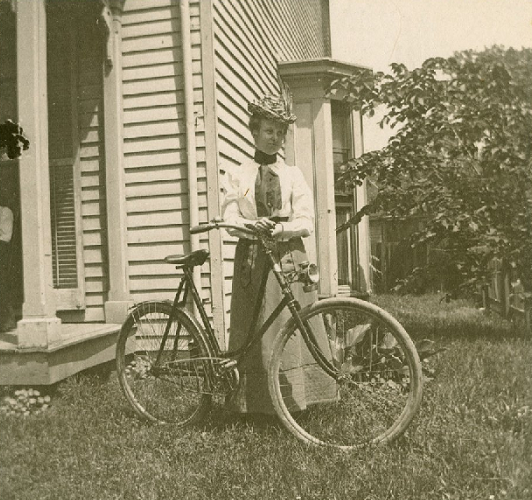
Now, to work on our form. One writer advised in the April 18, 1896 issue, that to be a good rider one must see that “every detail of her costume is correct” prior to mounting. Once atop your bicycle, do not “fall into the ungainly humped-up postures of many masculine riders” (p. 13). Sit upright as if on horseback, making sure to avoid “automatic stiffness” and “limp ungainliness.” Be careful to study the anatomy of the wheels, so as to be able to repair them in case of “small injury,” or at the very least familiarize yourself with repair prices. Do not be among the many women who struggle to “keep their mouths shut,” being that one doctor warned granite particles and microbes kicked up by a spinning wheel are injurious to one’s health (p.7).
Once you have gotten the hang of it, take great care not to ride like a “scorcher,” blazing down the beaten path at godforsaken speeds. Unless you hope to be a professional cyclist, this practice should only be undertaken by men. One is neither interesting nor attractive with her “hat awry, her hair disheveled, and her face scarlet with exertion.” Scorching also causes poor complexion and, perhaps worse, results in “muscles developed at the expense of her feminine grace.” The “inveterate scorcher” misses out on the beauty of land and sky in an attempt to ride as many miles as possible. Plus, you never know when you might cross paths with prominent bike enthusiasts like Clemens Vonnegut or Carl Fisher—you know what they say about first impressions.
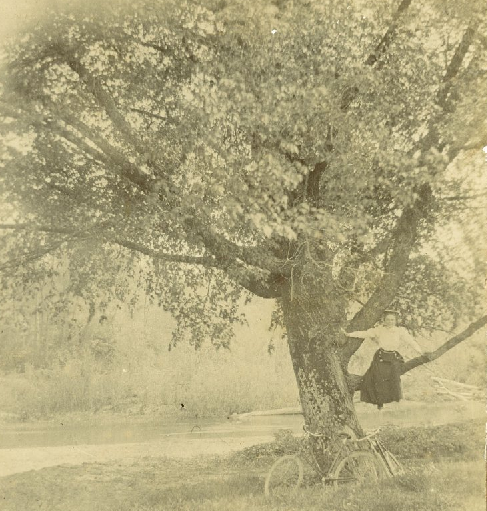
Whether you and your party are riding to the Indianapolis Country Club or countryside, the issue of greeting passersby remains. Should men and women forsake manners in the name of safety? Shall, one author in the July 11, 1896 issue asks, “a lady make a sweeping courtesy, or just one of those careless, saucy little good morning nods that sends a man’s heart up under his necktie and results in his speech becoming temporarily embarrassed?” (13). Do your best to maintain gentility, especially on “evening spins” as they have “led to a number of young people falling victim to Cupid’s wiles last year, and that the wedding bells rang out” for couples who met atop their wheels (May 15, 1897 issue, p. 10). If you are lucky enough to be struck by the mischievous cherub’s arrow, be sure to purchase a tandem bicycle to ensure the flames of romance remain stoked.
You’ve now used your wheels to explore the countryside, run errands at the market, and improve your health via “daily constitutionals.” While physicians agree that bicycling is permissible for women, even beneficial in moderate doses, you should heed one author’s advice before jumping into the “latest fad:” the bicycle dinner. The writer noted that pedaling from house to house over the course of eight meals, could “induce violent dyspepsia.” These indulgent dinner parties are an “American idea,” being that “No such a provocation to nervousness and indigestion would emanate from a foreign mind.”
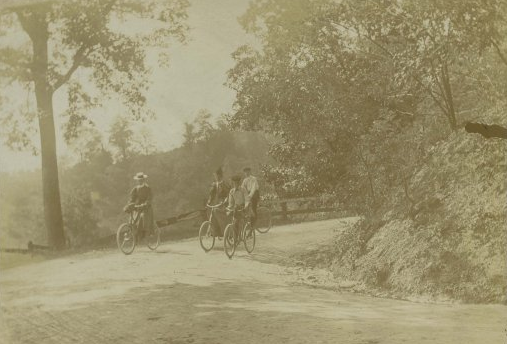
Mastering the art of the wheel as you have you, dear bicyclienne, you deserve to indulge in a little accessorizing. Perhaps you would like to document your escapades with a camera that hooks neatly onto your handlebars. A wicker basket for picnics is not only charming, but practical. Equip your cycle with all the handlebar bells and bangle whistles to alert passersby of your presence. A silver or gold scarf-pin in the shape of a cyclist or riding saddle lends a certain elegance to your fetching figure.
As you journey across Indiana’s many trails, bike paths, and parks— after faithfully oiling your wheels, of course—appreciate that the two wheels beneath you once helped transport Hoosier women to a more autonomous world. Godspeed, and for goodness sake, do not be a scorcher!
